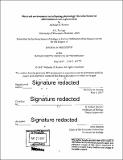| dc.contributor.advisor | H. Robert Horvitz. | en_US |
| dc.contributor.author | Burton, Nicholas O. (Nicholas Oscar) | en_US |
| dc.contributor.other | Massachusetts Institute of Technology. Department of Biology. | en_US |
| dc.date.accessioned | 2017-09-15T15:27:50Z | |
| dc.date.available | 2017-09-15T15:27:50Z | |
| dc.date.copyright | 2017 | en_US |
| dc.date.issued | 2017 | en_US |
| dc.identifier.uri | http://hdl.handle.net/1721.1/111294 | |
| dc.description | Thesis: Ph. D., Massachusetts Institute of Technology, Department of Biology, 2017. | en_US |
| dc.description | Cataloged from PDF version of thesis. | en_US |
| dc.description | Includes bibliographical references. | en_US |
| dc.description.abstract | From the 4th century BC until the late 19th century AD philosophers and biologists ranging from Hippocrates to Charles Darwin hypothesized that information about the environment could be passed from parents to progeny. However, in 1893, German biologist August Weismann tested these hypotheses and based on his observations concluded that information about the environment could not be transmitted from parents to progeny. Weismann's hypothesis became known as the Weismann barrier and served as one of the founding pillars of modern evolutionary synthesis, which postulates that genetic and phenotypic variability in plant and animal populations are brought about by genetic recombination resulting from sexual reproduction and random mutations. Nonetheless, throughout the 20th century there have been several observations of plants and animals where parental exposure to environmental stress modified offspring physiology. These changes in progeny physiology sometimes enhanced progeny survival in response to repeated environmental stress, suggesting that information about the environment might be passed from parent to progeny. The mechanisms by which parental environment can alter progeny physiology to enhance survival remain unknown. To explore such mechanisms I investigated how parental exposure of the nematode C. elegans to osmotic stress affects its progeny's response to continued osmotic stress. First, I found that C. elegans arrests its development during periods of osmotic stress to enhance survival and that this developmental arrest is caused by a loss of insulin-like signaling to the intestine. I then discovered that exposure of parents to mild osmotic stress enhances progeny resistance to osmotic stress and determined that this adaptation is the result of a loss of insulin-like signaling to the maternal germline, which results in increased expression of the glycerol biosynthetic enzyme GPDH-2 in embryos; the increased GPDH-2 expression results in increased glycerol production, which in turn protects progeny from osmotic stress. These results indicate that insulin can cross the Weismann barrier and suggest that changes in maternal insulin signaling might be responsible for effects of the maternal environment on human diseases that involve insulin signalling, such as obesity and type-2 diabetes. From a screen for mutants that fail to arrest development in response to osmotic stress I identified the cytosolic sulfotransferase SSU-1 and found that SSU-1 functions in the ASJ sensory neurons to control development and insulin-sensitivity in response to osmotic stress. | en_US |
| dc.description.statementofresponsibility | by Nicholas O. Burton. | en_US |
| dc.format.extent | 126 pages | en_US |
| dc.language.iso | eng | en_US |
| dc.publisher | Massachusetts Institute of Technology | en_US |
| dc.rights | MIT theses are protected by copyright. They may be viewed, downloaded, or printed from this source but further reproduction or distribution in any format is prohibited without written permission. | en_US |
| dc.rights.uri | http://dspace.mit.edu/handle/1721.1/7582 | en_US |
| dc.subject | Biology. | en_US |
| dc.title | Maternal environment and offspring physiology : the inheritance of information across a generation | en_US |
| dc.type | Thesis | en_US |
| dc.description.degree | Ph. D. | en_US |
| dc.contributor.department | Massachusetts Institute of Technology. Department of Biology | |
| dc.identifier.oclc | 1003283814 | en_US |
